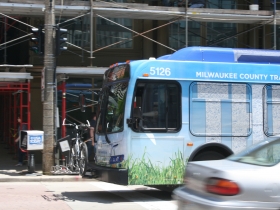Why Millennials Love Cities
There are many reasons, but a key one may be their crushing student debt loads.
Young people seem to be leaving the suburbs in droves.
As a recent New York Times story noted, suburban counties near New York City, like Westchester, Nassau and Suffolk, “have experienced a drop in the number of 25- to 44-year-olds, with the declines particularly sharp in more affluent communities. Between 2000 and 2011, Rye, for example, had a 63 percent decrease in 25- to 34-year-old residents and a 16 percent decrease in 35- to 44-year-olds.”
The trend could be seen in other metro areas. Outside Washington D.C., suburbs like Chevy Chase lost 34 percent of its 25- to 34-year-olds, Bethesda 19.2 percent and Potomac 27 percent. “The declines were comparable for Kenilworth, Winnetka and Glencoe outside Chicago, and Nantucket, Barnstable and Norfolk Counties outside Boston.”
Young people raised in the suburbs seem to find cities far more interesting places to live. You can see that in Milwaukee as graduates of UW-Milwaukee, Marquette or MSOE settle down to live in the city. The remarkable resurgence of Bay View and Riverwest has been driven by people in their twenties and thirties drawn to the vibrant urban scene there.
There are reasons to doubt this. For one thing, the sheer numbers of younger adults choosing the city are much higher than in previous eras. This has created a critical mass in neighborhoods like Bay View where the entire dynamic of the neighborhood is so transformed that it seems less likely to regress. For another thing, crime has been declining in the cities for some 20 years. Moreover, crime is a hyper-local phenomenon, so while it is very high in certain Milwaukee zipcodes, people in more upscale neighborhoods rarely encounter it.
But another factor that may make cities more attractive for young people is the rising level of student debt. For decades, state governments have been decreasing support of public universities, forcing them to jack up tuition. Since 1978, as a story in Bloomberg reported, the cost of college tuition has risen 12-fold — by 1,120 percent!
The result has been a soaring increase in student loans and resulting student debt. The percentage of 25-year-olds with outstanding student loan debt has grown to 43 percent through the end of 2012, up from just 25 percent nine years earlier.
The average 2014 graduate holding student loans owes $33,000, the Wall Street Journal has reported, up from around $31,000 in 2013 and way up from $10,000 for the 1993 graduating class.
A ball park estimate of the monthly payment on that debt, assuming 6.8 percent interest and a 10-year repayment plan, would be $370. And there are an awful lot of people facing this situation. As of 2012, 14 million Americans under age 30 owed money on student loans, followed by 10.6 million for the 30-39 group, according to a study by the Federal Reserve Bank of New York.
Adding difficulty is that many graduates aren’t getting the kind of high paying jobs needed to handle this crushing debt. An article on PolicyMic.com points out that between 2005 and 2012, the average student loan debt jumped 35 percent, adjusting for inflation, while the median salary dropped 2.2 percent.
As a result, younger people are more likely to put off buying a home or a new car. The share of younger households — headed by those under age 35 — who own their primary residence fell sharply from 40 percent in 2007 to 34 percent in 2011, according to the Pew Research Center. During this same period the proportion of these households with money owed on an automobile dropped from 44 percent to 32 percent. And during this same period the proportion of households headed by an adult younger than 25 who owned or leased at least one vehicle dropped from 73 percent to 66 percent.
If you rent rather than own a home, and if you don’t have a car, the city is a far more convenient place to live. And for technology-oriented young people, using their mobile phone to check when the next bus or streetcar or subway train is arriving, or to order a ride from an Uber driver, is a simple, convenient way to live.

Millennials want transportation options. Photo by Dave Reid.
All of which might help explain why the number of miles driven in cars has been declining for more than ten years. A study by WISPIRG found the average American aged 16 to 34 drove 23 percent fewer miles in 2009 than the average young person in 2001. Meanwhile, the number of passengers miles traveled by young people on public transportation increased 40 percent nationwide from 2001 to 2009. Additionally, young Americans also walked up to 16 percent more and biked up to 24 percent more than they did in 2001.
An April 2014 survey of Millennials in 10 U.S. Cities by the Rockefeller Foundation and Transportation for America found that 60 percent of Millennials want access to better transit options and the ability to be less reliant on a car. About 54 percent said they would consider moving to another city if it had better transportation options, and 46 percent said they would seriously consider giving up their car if they have a range of transportation options available.
A WISPIRG study of Wisconsin’s Millennials found similar results: 84 percent said that it was either “very important” or “somewhat important” for them to have transportation options other than a car to get around and 60 percent said they would be “somewhat more likely” or “more likely” to stay in Wisconsin after graduation if they could live in a place where they could get around without driving.
As the statistics suggest, this is about more than just economics or student debt. It’s about a different way of viewing the world, seeking more urban, more connected and more green ways to live. My 22–year-old son has no student debt and ready access to a car, yet he wanted to buy a bike. Why? Because all of his friends have one. If you want to combat brain drain, the adoption of bicycle-friendly policies is a pretty cheap way to make the city a welcoming place for recent college graduates.
A USA Today analysis of Census Data found there was a big increase in college grads flocking to cities from 2006 to 2011. The average increase in cities was 17 percent but it was 45 percent in Milwaukee, bigger than in all but one (San Antonio) of 20 cities the newspaper measured.
Personally, I am astounded at how Milwaukee has changed, and what an increasingly hip and urban place it has become. When I was a young college grad, the standard view of Milwaukee was that it was a second-rate city. Nowadays, most young people talk about how great Milwaukee is.
That’s not to say the suburbs will become passé, or that Milwaukee will have an easy time overcoming the problems associated with poverty in many of its neighborhoods. But for all its challenges, there is something remarkable happening in Milwaukee. I don’t think we’ve seen the end of the ongoing urban resurgence in this city or nationally. Yet it’s not at all clear that our politicians and policymakers are taking note of this trend, and how it should shape our decisions on transportation and a host of other issues.
Murphy's Law
-
The Last Paycheck of Don Smiley
 Dec 17th, 2025 by Bruce Murphy
Dec 17th, 2025 by Bruce Murphy
-
Top Health Care Exec Paid $25.7 Million
 Dec 16th, 2025 by Bruce Murphy
Dec 16th, 2025 by Bruce Murphy
-
Milwaukee Mayor’s Power in Decline?
 Dec 10th, 2025 by Bruce Murphy
Dec 10th, 2025 by Bruce Murphy



















Good stuff.. Milwaukee is a nice mix of urban and suburban neighborhoods (I’m talking about the actual city – yes, a lot of it is semi suburban in character). I must say, however, thad the school system is still a big problem and the number one thing that needs to be overcome. Good reliable public schools where kids don’t get shot are the final key to making the city come back to full and greater strength. Solve that problem and the population will really boom.
I don’t think it is the schools/teachers/administration which make the schools dysfunctional. As someone who attended a suburban school outside of Madison, you had a majority of students from two parent households who were engaged and able to participate in the education of their children. This is lacking for a number of reasons, and I would wager the biggest reason for the poor performance of students at MPS.
MPS is a symptom of a far greater problem affecting parts of Milwaukee: Generational poverty.
I think student debt plays a (smallish) part in a larger economic shift. Debt aside, it doesn’t make sense for me to spend tens of thousands of dollars (in cash) on a car-based lifestyle. Capital is hard to come by when you’re starting from scratch and there’s not enough ROI in a car. And as the middle class sloughs its way down the income distribution curve, access to capital becomes increasingly important.
I lived in Manhattan for the past several years before moving to Milwaukee recently. Milwaukee is indeed still a second rate city compared to NYC and the other world capitals. The deficit in culture, opportunity, lifestyle, transit, infrastructure, etc. is huge. I doubt that gap will ever close.
The advantage Milwaukee has over the major cities is that those places have already been claimed by the super wealthy. Young people still flock to NYC from all over the country, but they mostly live hand-to-mouth in order to participate in an upper class lifestyle they can’t really afford. They’re hoping to “make it,” but those places are for people who’ve already made it.
Technology makes it possible to live in an affordable city like Milwaukee and still participate in those larger economies. I think that differential is where opportunity lies for those of us born after 1980. Small cities will thrive if they can take advantage of it.
When it comes to transit, yes NYC beats Milwaukee, no question. But in other respects, like culture and lifestyle, no way is Milwaukee second rate in comparison to NYC (where I once worked and lived near). Bigger is not automatically better. Milwaukee has great cultural amenities and I’ll take the Milwaukee lifestyle over NYC’s any day of the week. Education and transit are where major improvements are needed.
I agree. Second rate is different than second tier. I prefer second tier. Anyway, the next step in Milwaukee’s evolution is to demand change. My hope is that the millennials that live here now will not up and move as their personal situation or values change. We need to demand the changes. For example, let’s not let a bureaucracy like MPS dictate to us how education is delivered, rather let’s dictate to them. Neighborhood schools are important. We need more effective public transit that provides options and improves mobility, and we should demand that too. These are only two examples of many. Let’s keep it going!
So attending MPS is why the students underperform versus the 17 hours a day the students aren’t at MPS?
Nice article.
Some of the problems cities face, like schools, will change along with the population.
Great article. I think one aspect (slightly alluded to by the previous comment) that this missed on is all the data about Millennials putting off major life events until later in life. Buying a house and car was touched on, but marriage and raising a family were left out. Millennials are waiting until their late 20’s and early 30’s to marry and have children. This allows them to maintain the kind of lifestyle that is better fit for an urban area vs. suburbs.
I wish I could say that I will stay in my apartment downtown once my wife (26) and I (30) have kids in a couple years. But, for many of the reasons stated in the article, we won’t. I recently sold my car and traded it in for a bus pass and ZipCar membership because it made more sense financially. With the increase in population downtown (Millennial and Baby Boomer), rents have increased rather significantly. Once affordable places in urban neighborhoods are no longer as such, making a move to a suburb more likely (student debt does factor in here, at $503 a month).
I would be curious how delayed major life events and rising urban prices factor in on Milwaukee’s urban growth. Add in some stats about Millennial employment (underemployment specifically) and I believe a clearer picture begins to emerge.
Finally, as boomers begin downsizing from suburban homes, urban living begins to appeal more to that generation as well (for those who have the ability and retirement savings left). I can see a rise in their generation pricing out Millennials in desired areas to raise families near urban centers.
Many factors to explore, but I do agree, the downtown Milwaukee I remember from 2005 to now is a drastically different and more vibrant area!
Bruce: the june 4 issue of The New Yorker features a cover (by another Bruce..McCall) of a kid riding a bicycle through space, on his way to making a delivery to a space station.Titled “Free Delivery,” it speaks to your article.
John, I never mentioned underperforming students. My point is that rather than allowing the bureaucracies to dictate policy, which MPS is, the people must demand change. One example would be neighborhood schools. There are many other examples.
As an avowed ‘urbanist’ (lived in central London, Dublin (Temple Bar) and downtown MKE (twice!)) the transformation that MKE is making is amazing. However, there will come a time in every Millenial’s life when they make the choice to have a family or not. If they do and live in the center of urbane scene, but squarely forced with sending their future children to MPS (I have no grudge here, I am an MPS graduate, Vincent HS , Class of ’87) or paying very high property taxes (either embedded in their rents or own their own property) AND private education tuition. Given that sharp distinction, they will likely opt for the ‘burbs. My wife and I, though we are middling Xer’s, started our married / household forming lives just a few years ago (I gave you my HS graduation year, you can do the maths!). We begrudgingly gave up our Lower East Side (rental) townhouse, where we loved walking to nearly everywhere and found a great mid-century ranch in Glendale. We’re still only a short drive to nearly everything, downtown included, but live in (and pay the high property taxes willingly for) one of the best school districts in SE WI. Inner ring suburbs like Glendale, Tosa, and Greendale should do very well attracting this next wave of suburban emigres and their school-age children as they are less ‘car dependent’, have reasonably priced / slightly aging housing stock and typically have their own walk-able urban mini centers, that are only a short drive away (think of limited range EV’s for a second car in the home).
This great challenge / trade-off will haunt all urban centers for the foreseeable future, leaving them to be inhabited by young 20/30 something, childless hipsters and aging 50/60 something “Hip-sters” (a term coined in a NYT article a few months ago on the movement of Baby Boomers which is tongue-in-cheek for the prime age group for hip replacement surgeries), so long as the monopolistic choice for primary / secondary education for all but the most affluent households is the ‘broken’ (for whatever Socio-Econ, stressed societal fabric reasons from the Left or Right you want to use to describe the reasons why they are) public school systems. And maybe that dichotomy in who the denizens of our urban centers and outer-lying communities is not a bad reality.
But if middling-sized, aspirational urban centers like MKE really want to move the needle on who lives in those centers and why, open the Choice / Charter programs to all but the highest incomes and have the State give every family in these geographies a voucher for tuition to ‘opt out of’ the monopoly educational system. Given that sea change, Millenials and subsequent generations likely would gravitate (and stay in buying homes as they can) to the ‘near in’ neighborhoods surrounding the centers which are near to or have the urban appeal they desire. If they had the choice of a differing educational path for their children that would likely appeal to a great many of them. Educational entrepreneurs would surely gravitate to these locales in short order, furthering the attractiveness of these (re-) emerging wards.
After reading our number one problem. The U’s have pork barreled their administration etc., so bad that their costs have risen way above reality. In 1962 my tuition was $106 or so. What now 50 years later? Criminal what they have done.
So WCD, you think it is “pork barreled” and not dwindling state support for higher education? My example is mostly California but I’m pretty sure it could be universal. http://www.dissentmagazine.org/article/from-master-plan-to-no-plan-the-slow-death-of-public-higher-education
As a former Mke resident who moved out to Greendale I agree 100% with Chris K. I believe that lot of people leave the city when it is time to raise their kids. MPS does have some good schools, but with no preference to neighborhood schools it leaves me unwilling to commit to a house. Before I looked in Greendale I considered Bayview, but I knew that Bayview has no long term solution for its high school. I still love all the new energy in Bayview, Walker’s Point and Downtown. I will probably move back into the City when my kids grow up and move away.